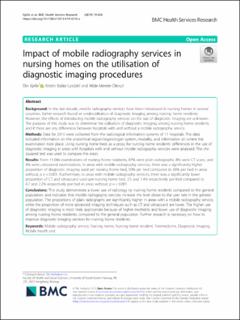| dc.contributor.author | Kjelle, Elin | |
| dc.contributor.author | Lysdahl, Kristin Bakke | |
| dc.contributor.author | Olerud, Hilde M | |
| dc.date.accessioned | 2020-03-13T13:59:53Z | |
| dc.date.available | 2020-03-13T13:59:53Z | |
| dc.date.created | 2019-07-22T15:35:25Z | |
| dc.date.issued | 2019 | |
| dc.identifier.citation | BMC Health Services Research. 2019, 19 (1). | en_US |
| dc.identifier.issn | 1472-6963 | |
| dc.identifier.uri | https://hdl.handle.net/11250/2646782 | |
| dc.description | Open Access This article is distributed under the terms of the Creative Commons Attribution 4.0 International License which permits unrestricted use, distribution, and reproduction in any medium, provided you give appropriate credit to the original author(s) and the source, provide a link to the Creative Commons license, and indicate if changes were made. | en_US |
| dc.description.abstract | Background:In the last decade, mobile radiography services have been introduced in nursing homes in severalcountries. Earlier research found an underutilisation of diagnostic imaging among nursing home residents.However, the effects of introducing mobile radiography services on the use of diagnostic imaging are unknown.The purpose of this study was to determine the utilisation of diagnostic imaging among nursing home residentsand if there are any differences between hospitals with and without a mobile radiography service.Methods:Data for 2015 were collected from the radiological information systems of 11 hospitals. The dataincluded information on the anatomical region/organ/organ system, modality, and information on where theexamination took place. Using nursing home beds as a proxy for nursing home residents’differences in the use ofdiagnostic imaging in areas with hospitals with and without mobile radiography services were analysed. The chi-squared test was used to compare the areas.Results:From 11,066 examinations of nursing home residents, 87% were plain radiographs, 8% were CT scans, and4% were ultrasound examinations. In areas with mobile radiography services, there was a significantly higherproportion of diagnostic imaging used per nursing home bed, 50% per bed compared to 36% per bed in areaswithout;p=< 0.001. Furthermore, in areas with mobile radiography services, there was a significantly lowerproportion of CT and ultrasound used per nursing home bed, 2.5 and 1.4% respectively per bed compared to4.7 and 2.2% respectively per bed in areas without;p=< 0.001.Conclusions:This study demonstrate a lower use of radiology by nursing home residents compared to the generalpopulation, and indicates that mobile radiography services increase the level closer to the user rate in the generalpopulation. The proportions of plain radiographs are significantly higher in areas with a mobile radiography service,while the proportion of more advanced imaging techniques such as CT and ultrasound are lower. The higher useof diagnostic imaging is most likely appropriate because of higher morbidity and lower use of diagnostic imagingamong nursing home residents, compared to the general population. Further research is necessary on how toimprove diagnostic imaging services for nursing home residents. | en_US |
| dc.language.iso | eng | en_US |
| dc.rights | Navngivelse 4.0 Internasjonal | * |
| dc.rights.uri | http://creativecommons.org/licenses/by/4.0/deed.no | * |
| dc.title | Impact of mobile radiography services in nursing homes on the utilisation of diagnostic imaging procedures | en_US |
| dc.type | Peer reviewed | en_US |
| dc.type | Journal article | en_US |
| dc.description.version | publishedVersion | en_US |
| dc.rights.holder | © The Author(s). 2019 | en_US |
| dc.source.pagenumber | 9 | en_US |
| dc.source.volume | 19 | en_US |
| dc.source.journal | BMC Health Services Research | en_US |
| dc.source.issue | 1 | en_US |
| dc.identifier.doi | 10.1186/s12913-019-4276-x | |
| dc.identifier.cristin | 1712340 | |
| cristin.ispublished | true | |
| cristin.fulltext | original | |
| cristin.qualitycode | 2 | |

